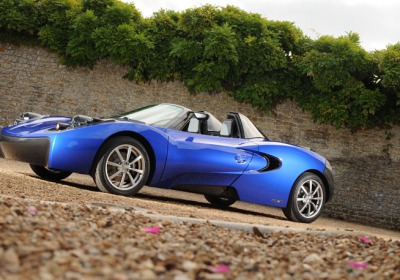Teewave AR1 (2011) - Gordon Murray's roadster unveiled
Wed, 21 Sep 2011
It may have a daft name - let's face it, driving a car called a Teewave does sound terrifically uncool - but Gordon Murray Design's latest creation is a very important vehicle.
The Teewave AR1 not only showcases the Surrey-based company's design and engineering capabilities that elevate it to full design studio status, but also illustrates the very sweet spot where engineering integrity, lightweight material and want-one design meet.
We joined design director Barry Lett at GMD on the day Project T32 was being primed for shipment to Tokyo for its public debut by Toray.
Never heard of Toray? Join the queue…Toray Industries is one of those companies whose products we use on a daily basis without even realising. It's the world’s biggest producer of carbonfibre and sits at the very pointy end of lightweight materials technology.
With 39,000 staff spread across 19 countries turning over £12.4 billion, it's a heavy hitter. Every year it holds its own trade fair - it's that big - and rather than display a raft of different materials it called on Gordon Murray Deisgn to create not just an electric concept car but a full road-ready sports car that could be put into full-scale production. And GMD delivered the Teewave AR1.
The Teewave AR1 - the lowdownThe first thing you should know about the AR1 is that it looks far better in the composite than it does in photographs. Image the illicit offspring of a Zonda and an Elise and you'll get the idea. We think the design team, lead by Andy Jones and Zachary Seward, has done an intriguing job of packaging the innards of the Mitsubishi i-MiEV donor car into something fresh, modern and realistic.
'We went for something believable and current,' explains Seward. 'If you saw this flying down the road, we wanted to be sure you’d know it was a car for today, not a mad slight of fantasy.
'We had just nine months from start to finish,' says Barry Lett. 'That mean that everything had to work first time. It was quite a challenge - and then we decided that if we were going to make it a runner, we might as well ensure that every aspect of it could be homologated. It was a good proving point for the company. Toray knew we would deliver.'
What's the AR1 like in the plastic?Walk around the AR1 and you can see how the exposed carbonfibre - so beautifully lacquered and aligned it's hard not to reach out and caress it - acts as a visual link with the carbonfibre that underpins the entire structure, including the 43kg single piece central tub.
Everything – everything – was done inhouse, including crash-testing. The entire car was digitally designed. 'There were no full-sized clays – we went from 30 percenters to full-size,' says Frank Coppuck, the T32’s engineering director.
Electric power, naturallyThe i-MiEV battery pack and engine sit between rear axle and passenger, which explains the longer-than-expected 2610mm wheelbase. Coppuck and his team shied away from fettling the powertrain, so although the AR1 only packs a featherweight 63bhp and 133lb ft performance punch, factor in a low 840kg kerb weight, track-honed double wishbone suspension, ultra quick steering and powerful brakes and you get what Coppuck describes as a engaging package.
'We could squeeze a lot more out of the engine,' says Coppuck. As is, the T26 has a top speed around 100mph, a usable 100 mile range and a maximum recharge time of eight hours on 240V domestic mains.
'It’s a laugh to drive – there is loads of bottom-end torque and gets up to its top speed very quickly.'
So is this one-off car built for a Japanese materials giant few of us have heard of important?We believe so, not just for the technology it incorporates but because it's been designed as a full turn-key operation that's primed for production. Just imagine imagine if Nike, Apple or Virgin decided to build the AR1. It would not only irrevocably change the way we view cars but also the companies that make them.
By Ben Whitworth

